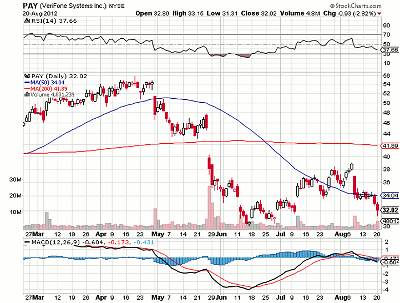Terri Stridsberg of Schaeffer’s Research highlights one option play on a stock that has been in a recent downward trend.
Calls are in high demand on VeriFone Systems (PAY) early this week, as nearly 7,200 of these options changed hands on Monday alone—nearly seven times the norm, and over six times the number of puts traded. Most active has been the out-of-the-money September 35 strike, where north of 2,400 calls have been exchanged at a volume-weighted average price of 81 cents.
Additionally, almost all of these contracts traded at the bid price, suggesting they were sold. However, because current open interest levels exceed today's volume, it cannot be said for certain if new positions are being added at this strike. If these calls are, in fact, being sold to open, traders are expecting the stock to remain below the $35 mark through September expiration.
Digging deeper into the data, it appears that several blocks totaling 1,975 calls were purchased at the September 31 strike for $2.45 each, while an equal number of calls were sold at the September 33 strike for $1.45 apiece—yielding a net debit of $1. Because today's volume at these strikes surpasses current open interest levels, it's possible that one trader has initiated a bull call spread on PAY.
In this strategy, the speculator is counting on the stock to close above $32 (bought strike plus net debit) by the time September expiration rolls around. His maximum profit is limited to $1 per pair of contracts, or the difference between the strike prices, minus the net debit. On the other hand, his potential loss is capped at the net debit paid to establish the play.
Today's upswing in PAY call activity is par for the course, as the stock sports a ten-day International Securities Exchange, Chicago Board Options Exchange, and Nasdaq OMX PHLX call/put volume ratio of 3.20—confirming that calls bought to open have more than tripled puts during the past couple of weeks. This ratio arrives in the 73rd percentile of its annual range, meaning traders have been buying calls over puts at an accelerated clip.
It should be noted, however, that while short interest on PAY declined by nearly 15% during the past month, these bearish plays still account for more than 9% of the equity's float—implying that some of the aforementioned buy-to-open call volume could be attributable to short sellers looking to hedge their bets. Either way, it would take roughly six days to buy back these shorted shares at the stock's average daily volume.
Despite receiving a downgrade earlier this month, PAY still boasts six "strong buys" and two "buy" endorsements, compared to four "holds" and one "strong sell" suggestion. What's more, the security's average 12-month price target—as noted by Thomson Reuters—sits at $46, representing expected upside of nearly 40% to recent closing prices around $32.
PAY, which has declined by almost 11% year-to-date, and lagged the broader S&P 500 by about 32 percentage points over the past three months—is now trading well below resistance at its 40-day moving average, thanks to today's 4.5% decline in the shares.
The stock has also perforated support at the $33 level for the second time since mid-July. Should PAY continue its current slide, today's bearish call writers could end up pocketing the premium received for selling the September 35 options.
Terri Stridsberg can be found at Schaeffer’s Research.






















